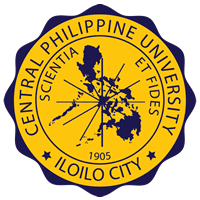By Francis Neil G. Jalando-on

In an article on April 1946 by The Central Echo, one headline says, “They Cast a Powerful Shadow on the Campus.” They have been called “shadows” because oftentimes the American missionaries were always featured in the news. These three “shadows” were Urbano Nequin, the Registrar and Secretary; Mariano Caipang, the Comptroller; and Prof. Juan Sornito, the Supervising Engineer. They were described as “Great souls these – but unknown.” It is then the responsibility of the new generation of Centralians to know more about these people.
Let’s get to know more about these distinguished Centralians.
Urbano Nequin was described as “Faithful, strict custodian of the college records. Chief consultant of the administration and far-flung policies.”
Linnea A. Nelson and Elma S. Herradura in their book Scientia et Fides The Story of Central Philippine University published in 1991 told “The Saga of the Nequins and the School Records.” It recounted how Mr. Urbano Nequin and his family secured the records of the Registrar’s Office. When they knew that war would be coming to Iloilo, Mr. Nequin decided to bring his family to the hills of Calinog. Rev. R. Fred Chambers, President of CPC during that time, came to Calinog with a jeep and delivered the records that Mr. Nequin prepared for transport. They put the records in a cave in which their nipa house stood. Later they secured the records by putting it inside an empty metal water tank. Mr. Nequin joined the guerrillas, and it was up to Mrs. Teofila D. Nequin to take care of the records. When there was rain, Mrs. Nequin and their small children would roll the tank to their house. When alerted that Japanese soldiers will come in their area, they would roll the tank back to the cave again. When the war was over, they put the records inside the pillows, wrapped them with banana leaves and secured them at the top part of their house. It was a miracle that when CPC opened its doors in 1946, all the records of the Registrar’s Office were intact. And as of this time, all records before World War II are still with us.
Mariano Caipang was remembered for “His mastery of college finance placed Central Philippine College ‘in the black’ in spite of dire predictions. He is the campus reconstruction administrator.” If you wonder what “in the black” means, it is the opposite of “in the red” – operating in a loss. This tells us that Mr. Caipang did a marvelous job as a Comptroller after the war – balancing the books of the school while pouring money into the reconstruction of the campus after destruction brought by World War II.
One of the notable things that Mr. Caipang did was to preserve the records of the Business Office before and during World War II. Together with the cashier, Mr. Jovito Gonzales they inventoried all the physical properties of CPC before the hostilities arrived in Iloilo. Every weekend, Mr. Caipang would bring the records to Leon for safekeeping. Upon knowing that the Japanese soldiers were coming, Mr. Gonzales took the college cash box, put it in a large sack together with canned goods. He was then able to ride the last bus going to Leon. Together with Mr. Caipang, they ingeniously buried the sack with the cash in an open toilet pit. Later, when the war was over, the money that they hid was used for the immediate repairs of the campus. CPC would later receive war reparations under the Philippine Rehabilitation Act of 1946 due to diligent pre-war inventory efforts of Mr. Caipang.
Many alumni also testified about the compassion of Mr. Caipang. He would often sign promissory notes when poor but deserving students cannot pay their tuition fees on the prescribed time. These alumni who would come back during reunions in the campus would always visit Mr. Caipang and thank him for what he has done. Later, Mariano Caipang became the Vice President for Finance when CPC became Central Philippine University. He served CPU for 40 long distinguished years.
Prof. Juan Sornito, on the other hand, was greatly remembered for “He reconstructed five buildings on the old campus.” It was indeed a short statement, but the magnitude of what he has done speaks volumes. In another article, The Central Echo bannered this headline: “Back to the Old Campus. Destroyed Buildings Now Repaired; Prof. Sornito Is Guiding Engineer.”
In order to appreciate what Engr. Sornito has done, we have to describe the results of the war: “All buildings and equipment were levelled to the ground or reduced to ashes, except for six modern concrete structures, shells of which remain standing either lightly or badly damaged. They are: Valentine Hall (administration and classrooms), Lopez Hall (mess hall for boys), Franklin Hall (boy’s dormitory), Roblee Hall (Science building), Weston Hall (girl’s dormitory), and the President’s House. Words cannot describe the extent of the damage done. All that can be said is that the destruction is TOTAL in capital letters.” All of these were reconstructed and were ready for the classes that started on July 1946. Engr. Sornito worked closely together with Comptroller Caipang and Meliton Sornito as foreman. The Chairman of the Board of Trustees, Don Ramon Lopez, was also tasked to oversee the overall reconstruction effort.
The Central Echo gave tribute to these three men – “These men carry more than their ordinary load for which they get no salary; they go out of their way and do a lot more things than many people know, testimony of their talents and their consecration. We have seen Mr. Nequin fall ill at his desk, Prof. Sornito sleep at 2 o’clock in the morning pondering over engineering figures, Mr. Caipang hiking in the rain in shirt sleeves collecting pledges and looking after the campus property.”
These people played a big role in Central’s history. And when we remember them, and learn lessons from them, they’re not considered “shadows” anymore.
